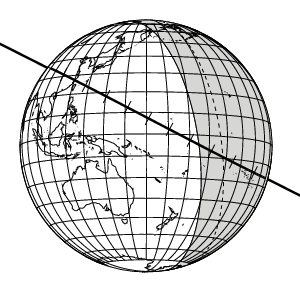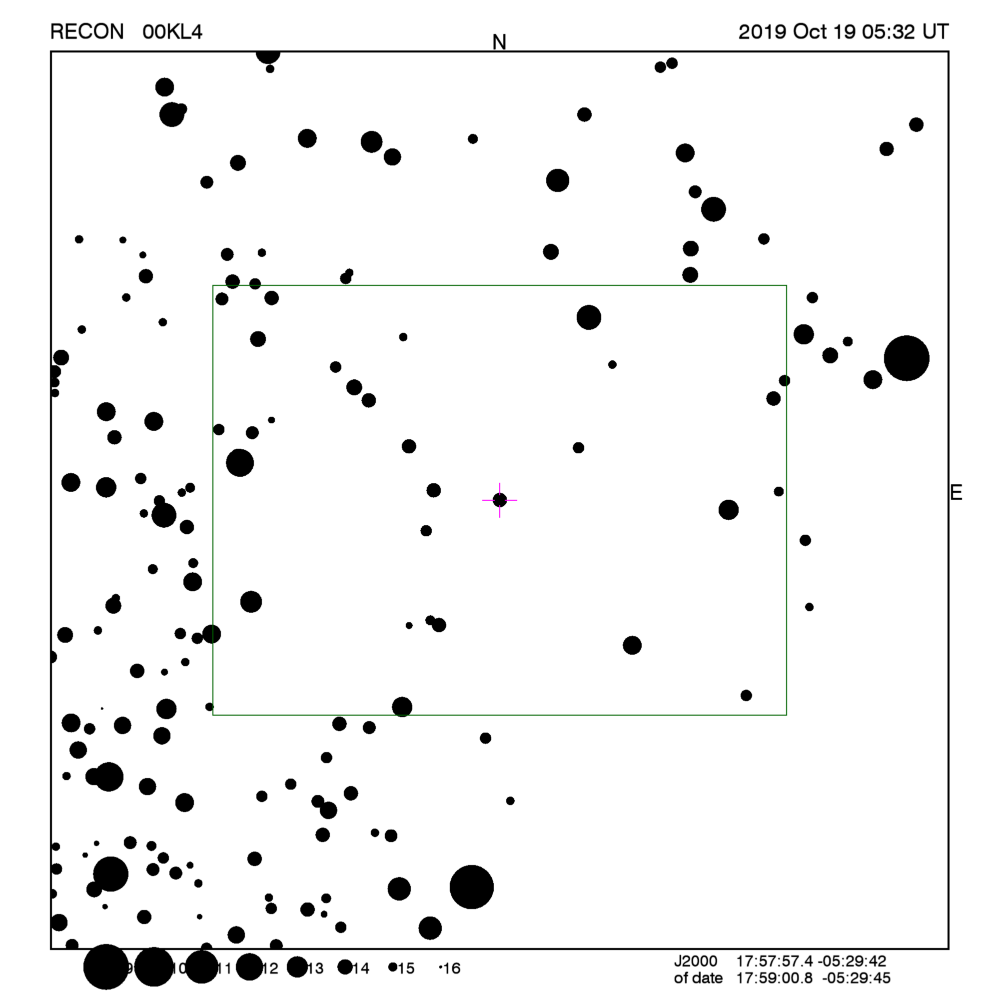RECON: TNO occultation with 00KL4
Event between 00KL4 and star GA0840:06793902
with event index number of 214424
Geocentric closest approach at 2019/10/19 05:29:27 UTC
J2000 position of star is 17:57:57.4 -05:29:42
Equinox of date position of star is 17:58:57.4 -05:29:45
Stellar brightness G=14.3,
use SENSEUP=64
Star is 163 degrees from the moon.
Moon is 74% illuminated.
TNO apparent brightness V=23.7
 TNO is 39.2 AU from the Sun
and 39.6 AU from the Earth.
TNO is 39.2 AU from the Sun
and 39.6 AU from the Earth.
The TNO is moving 20.2
km/sec on the sky relative to the star, or,
2.5 arcsec/hr.
The 1-sigma error in the time of the event is 313 seconds.
The 1-sigma cross-track error in the shadow position is
3428 km.
The TNO has an absolute magnitude Hv=7.6
Diameter=184.5 km assuming a 5% albedo -- 9.1 sec chord
Diameter=75.3 km assuming a 30% albedo -- 3.7 sec chord
Dynamical classification is SCATEXTD
Star training set for 00KL4, (2019/10/19 05:29UT)
Object RA Dec mag sep mel
Antares 16:30:37.5 -26:28:27 0.9 29.74 162
60Bet Oph 17:44:27.1 +04:33:37 2.8 10.69 153
PPM 201278 18:00:39.9 -04:49:17 5.8 0.79 162
PPM 201256 17:59:49.2 -05:25:31 7.9 0.21 163
PPM 201239 17:58:57.5 -05:41:13 9.3 0.19 163
00KL4 17:59:00.8 -05:29:45 14.3 163
Positions are for equinox of date

Azimuth is measured in degrees eastward from north.
North is at an azimuth of 0, due East is at an azimuth
of 90 degrees, due South is 180, and due West is 270.
Do not use the listing below for the RECON CPC 1100 telescopes.
This is provided for other non-team facilities.
Star training set for 00KL4, (2019/10/19 05:29UT)
Object RA Dec mag sep mel
Antares 16:29:24.4 -26:25:56 0.9 29.74 162
60Bet Oph 17:43:28.3 +04:34:05 2.8 10.69 153
PPM 201278 17:59:36.8 -04:49:18 5.8 0.79 162
PPM 201256 17:58:45.8 -05:25:30 7.9 0.21 163
PPM 201239 17:57:54.0 -05:41:11 9.3 0.19 163
00KL4 17:57:57.4 -05:29:42 14.3 163
Positions are for J2000
Event circumstances last updated at 2018/09/23 17:56:50 UT
Marc W. Buie,
Southwest Research Institute
RECON
 TNO is 39.2 AU from the Sun
and 39.6 AU from the Earth.
TNO is 39.2 AU from the Sun
and 39.6 AU from the Earth.
